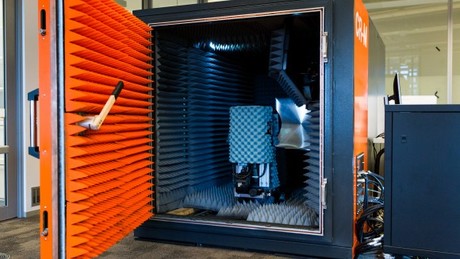UTS commissions 90 GHz test chamber

The Faculty of Engineering and IT (FEIT) at the University of Technology Sydney (UTS) has commissioned a new antenna chamber that will extend capabilities in wireless communications systems research for 5G, future Wi-Fi and millimetre-wave applications.
The mini compact range (CR-Mini) antenna measurement system can examine frequencies up to the 90 GHz (millimetre wave), a first among all Australian universities, helping the expansion of advanced mobile applications and faster data transfers.
The resource was custom-built in Israel by Microwave Vision Group (SATIMO, ORBIT/FR, MVG-EMC), which delivers EMC and antenna measurement systems and components.
The system provides fully automated antenna measurement, analysis and presentation capability in accordance with IEEE standards.
It is incorporated into a shielded anechoic chamber together with equipment test and feed positioners, a radiofrequency system, data acquisition and control and a turnkey facility dedicated for antenna (up to 30 cm size) measurements over a frequency range of 8 to 26.5 and 60 to 90 GHz.
It includes MiDAS, a user-friendly antenna measurement software suite with an intuitive graphic interface.

The CR-Mini was fully assembled and checked at ORBIT, then disassembled, shipped and reassembled following structural modifications at the faculty’s building on Broadway.
“UTS has invested over $800,000 in this unique millimetre-wave measurement technology, which will make a great contribution to our industry collaborations. This includes our recent agreement with Nokia to collaborate on developing IoT-based business applications using high-speed, ultralow-latency technologies such as 5G,” said Distinguished Professor Jay Guo, Global Big Data Technologies Centre, FEIT.
It will also be used by research staff and students, and for teaching and learning in the new Data Engineering degree offered for the first time in 2017 by FEIT.
“This latest state-of-the art addition to our testing facilities, together with the outstanding people we have working in our research areas, strengthens our position as the number one wireless team in Australia and one of the top five teams worldwide,” said Professor Guo.
The CR-Mini is the latest UTS acquisition, which, together with a large anechoic chamber and terahertz measurement facilities to be built at UTS’s new Botany site, extends UTS’s capability as a world leader in millimetre-wave research.
Delivering the 1.7-tonne chamber to its new base at UTS was a large task. It took three staff three days to reassemble the chamber in situ, the heaviest single part weighing in at 500 kg.
Software and system installation and testing were completed within three days of the chamber assembly.
“I think it was quite unique how both teams, from Australia and Israel, worked together to overcome the ‘elevator obstacle’ with a lot of thinking and cooperation on both sides,” said Yoram Mor, chief software & system engineer, ORBIT FR Engineering.
“This process took a lot of resources and was time-consuming, but there was a real ‘can do’ attitude on both teams and I think this is one of the things that makes this system special.”
RFUANZ report: setting the frequency for success in 2025
Last year brought a lot of internal change for RFUANZ, but the association has hit the ground...
ARCIA update: an extended event calendar for 2025
With the addition of Tasmanian events and a conference in Adelaide in September, 2025 will see...
ARCIA update: plans for 2025
ARCIA will be holding a mixture of workshop, conference and networking events in 2025, in the...





